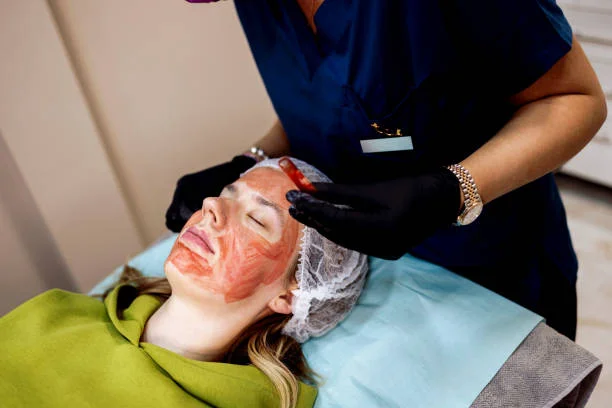Microneedling is a skin repair and rejuvenation treatment that uses a mechanical device with multiple tiny needles to create controlled micro-injuries in the skin. The aim is to stimulate the body's natural wound-healing process and collagen production, which is why microneedling is also known as "collagen induction therapy."
The result is increased cell turnover and the formation of new and stronger collagen and elastin fibres. This helps to treat many skin problems such as acne scars, wrinkles, sagging skin, stretch marks and skin discolouration.
But to really understand and appreciate why this is such an effective anti-ageing treatment, we need to take a look at the history and evolution of microneedling.
The History of Microneedling
Microneedling is one of the oldest beauty rituals that has stood the test of time for good reason. Even in ancient China there was a form of microneedling. A book called The Yellow Emperor's Classic of Internal Medicine from 100 BC describes the use of needles to heal the body.

This is what we know today as acupuncture. At that time it was used to open channels or conduits to allow qi (vital energy or life force) to flow. The emperors also pricked needles into the skin to cure blemishes. They believed that these blemishes were a sign of damage to the internal organs and that by treating the face, the internal organs could be restored.
Nowadays, acupuncture is used to improve the body's functions and promote the natural self-healing process - and microneedling does just that.
But it was not until the early 1900s that microneedling became commercially available for aesthetic treatments.
In 1905, the first known microneedling device with an electric motor was used by German dermatologist Ernst Kromayer. His technique used rotating wheels and rasps to ablate the skin in a controlled manner. The aim was to treat acne scars, keratoses and hyperpigmentation
Soon after, medical tattooists discovered that after repeated sessions of tattooing patients with skin-coloured ink, they found that it was not the pigment but the needles themselves that caused the scar tissue to recede. Although this was not the intention of medical tattooing, it shed new light on skin rejuvenation, opening the door for further medical research.
In 1996, Canadian plastic surgeon Dr Andre Camirand discovered that piercing the skin with tattoo needles significantly improved facial scar texture and broke down scar collagen. His patients' scars had improved tremendously in terms of skin texture and overall colour.
The next development came the same year when Dr Des Fernandes, a plastic surgeon, introduced his own needling device, which consisted of a small needle stamp as well as a hypodermic needle that was regularly used in his surgical practise to stimulate collagen production.
Dr Fernandes pioneered skin-needling techniques that eventually became internationally recognised as the safest and most effective method of treating sagging skin, wrinkles, scars and stretch marks.
A few years later, German inventor, Prof. Horst Liebl was looking for a new and much faster method of microneedling. He integrated almost 200 non-traumatic medical-grade microneedles into a drum-shaped device. Now the previous "static" needling was transformed into a "dynamic" microneedling procedure to treat larger areas of skin in less time. He called his invention Dermaroller and had it patented and trademarked in the year 2000.
The Evolution of Microneedling
From the simple dermaroller, microneedling has evolved over the last two decades to include new technologies.
Some of the significant developments include:
Home-care Dermarollers
Home care derma rollers, as the name suggests, are used by patients themselves in the comfort of their own homes.

This involves rolling a small wheel with hundreds of tiny needles over the face to gently prick the skin. When used in conjunction with a serum, this skin treatment can greatly increase the absorption of skincare ingredients. Indeed, this is one of the greatest benefits of microneedling - the transdermal delivery of anti-ageing products.
There are countless derms rollers for home use on the market. We recommend that you make sure that the device you choose is well-rated and from a verified seller.
The next point you need to consider is the needle size. We strongly advise you to only use needles with a depth of 0.3 mm or less.
How often you work with the derma roller also depends on the length of the needles you use. Below you will find the maximum number of applications you can perform with the dermaroller within a certain period of time. Remember: the longer the needles, the deeper the wound - and the longer the recovery time.
| 0.25 mm | every other day |
| 0.5 mm | 1–3 times a week (starting with less) |
| 1.0 mm | every 10–14 days |
| 1.5 mm | once every 3–4 weeks |
| 2.0 mm | every 6 weeks (always go to professional) |
If you want to perform a deeper microneedling treatment with a larger needle size, we recommend that you consult a professional. Even one wrong derma product or treatment can irreversibly worsen the condition of your skin. This may eventually force you to seek professional help, and the cost of restoring your skin to its previous condition will likely be even higher.
Derma Stamp

These are miniature versions of the dermaroller, available in different needle lengths (0.2-3 mm) and a diameter of 0.12 mm. Derma stamps are used for localised scars such as varicose scars. The advantage over the dermaroller is that a more focused treatment of individual scars is possible.
It causes vertical penetration to create infusion channels in the skin and is considered ideal for use on isolated scars and wrinkles. Similar to the home dermaroller, the derma stamp can be used in the comfort of your own home
Microneedling Pens
This technology was developed to overcome the problem of varying pressure application and resulting penetration depth that occurs with hand-held derma rollers.
It is an automated microneedling device that looks like a pen and offers several advantages over the traditional dermaroller.
- The device uses disposable needle cartridges and precision guides to adjust the needle length.
- The tip has 9-12 needles arranged in rows (instead of hundreds of needles in the dermaroller).
- The device is also powered by a rechargeable battery and works in two modes, high-speed mode and low-speed mode.
- Its ergonomic shape makes it more convenient to treat narrow areas such as the nose, eye area and lips without damaging the adjacent skin.
You should never attempt to use these devices at home as these microneedling devices should only be administered by professionals.
One of the leading microneedling pens on the market is SkinPen.
These devices also allow for even more efficient delivery of serums and other anti-ageing products into the skin.
You've probably seen the photos of celebrities or beauty content creators on Instagram in recent years whose faces appear to be smeared with blood. This is a skincare treatment often referred to as a "vampire facial" or platelet-rich plasma therapy (PRP).

It is basically a mask made from the platelet portion of their own blood and applied to the face after microneedling. The platelets contain pockets called alpha granules that secrete large amounts of growth factors which essentially enhance the effect of microneedling. In this way, cell turnover and the production of collagen and elastin are increased by double or even more.
At Dr Asthetica, we use a similar technique, but instead of drawing your own blood, we use potent growth factors that have been bioengineered in the lab. We have even written a whole article demystifying the role of growth factors in skincare.
Radiofrequency Microneedling
Those familiar with radiofrequency skin tightening have probably come across the term radiofrequency microneedling. This non-surgical skin anti-ageing technique uses a device with specially insulated needles that deliver high-intensity radiofrequency energy into the target tissue once the needles have penetrated the skin.
The device uses thicker needles that create fewer microchannels but deliver heat deep into the skin. The basis of this therapy is thermal coagulation of the tissue to stimulate the denaturation and renewal of collagen in the dermis. So in reality it is a heat-based therapy and not a microneedling therapy. Nonetheless, we've included it here as it borrows some of the principles of microneedling.
Final Thoughts
Microneedling has quickly emerged as one of the safest and most effective procedures that can improve the appearance of the skin. The list of possible uses for micro-needling technology will only continue to grow as advances are made and more devices are introduced to the market.
Whether you are looking to combat the telltale signs of ageing or simply rejuvenate your skin, this is definitely a treatment you should have in your arsenal. And if you do decide to go the professional treatment route, feel free to contact our friendly and knowledgeable staff for more details.
Dr Aestehtica is a premier medical aesthetics clinic serving patients in the greater Birmingham area.
Feel free to contact us about Microneedling in Birmingham or to view more information on this procedure click here:


